Grenade School
The following is taken from French Trench Warfare, 1917-1918: A Reference Manual, and the Manuel du Chef de Section d'Infanterie ("The Manual of the Infantry Section Leader") dated January 1918.
Another excellent source is Grenade Warfare: School of the Grenadier - A Guide For Hand Bombers and Rifle Grenadiers by Capt. Adrien Gay.
Individual Instruction
Individual instruction in the use of hand grenades was given to all soldiers without exception. By 1916, the hand grenade had become an indispensable part of the infantryman's arsenal. The possession of grenades (particularly when had in great abundance) meant the difference between success and failure in raids and attacks, and often life and death as well. Soldiers would have received as part of this instruction lessons on the proper dismantling and handling of grenades, throwing exercises, and proper employment of grenades in combat. Those who were specially designated as grenadiers received additional, more in-depth instruction (see below).
THROWING
The grenade should never be thrown low or thrown with a bent arm. In other words, it was not thrown like a baseball. Rather it was a matter of "plunging" or lobbying the grenade in an arcing motion. The process below was modified according to the various positions in which the soldier finds himself (kneeling, lying prone or behind an object).
1.
Prime grenade (either by lighting or striking primer, or pulling safety-pin, depending on the model being used).
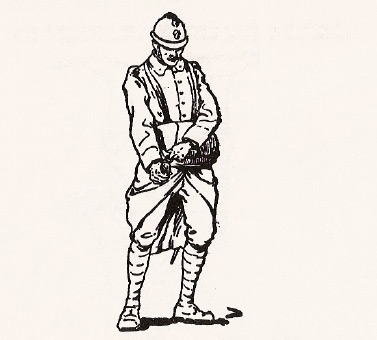
2.
Aim at the intended target by extending left arm and fixing left hand in the direction of the target, the grenade being held in the right hand.
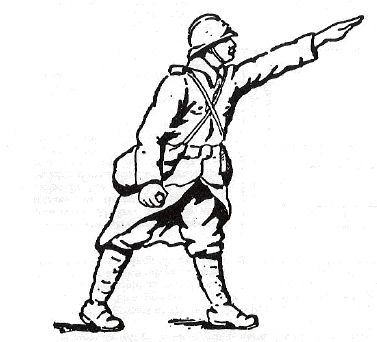
3.
With the left arm kept in the direction of the target, the right arm is carried back.
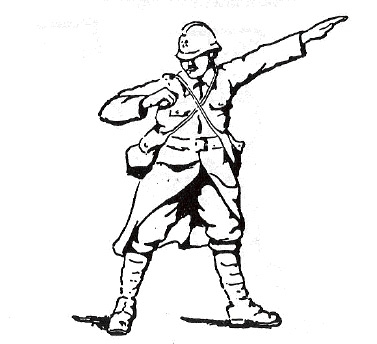
4.
The left arm still fixed in the direction of the target, the right hand back and the right arm extended fully, look at the grenade to check that nothing will hinder its throwing.
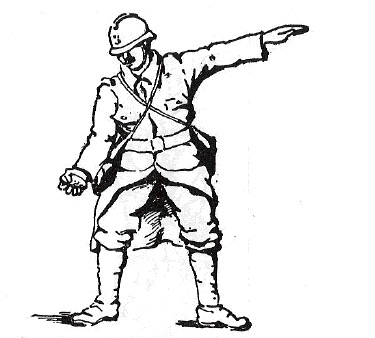
5.
Look again at the target and with the right arm describe a vertical arc.
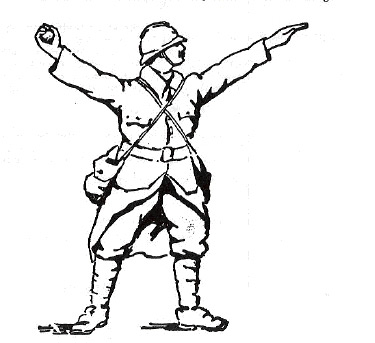
6.
Release grenade, the right shoulder and body following through in the movement of the arm. The left arm follows the left shoulder which is refused. The grenade will go in the direction which the left arm was aimed.
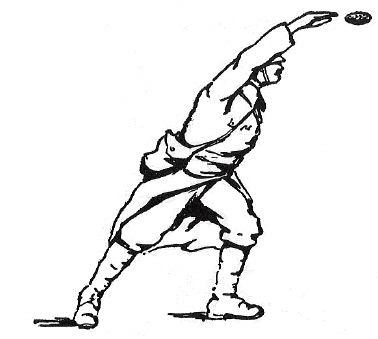
THROWING EXERCISES
At first soldiers are trained to throw dummy grenades in the open field at measured distances. The trenches, represented by two parallel lines drawn on the ground one meter apart, are placed at increasing distances from the thrower. One example is given below, where the trenches are situated at 20, 25, and 30 meters. The throwers in trench 'A' take their places and try to toss their grenades in trench 'B'. Successively, they try longer ranges by first attempting to throw the grenade in trench 'C' followed by 'D', and so on.
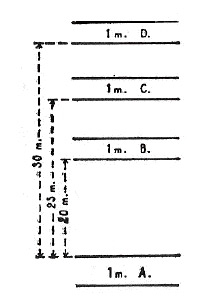
The training groups may be divided into two, with one half at the throwing line and the other at the target. The latter then throw back the grenades upon their turn, and so on. Skill and precision can be developed by the use of targets drawn on the ground meant to simulate dugouts, defilades, machine-gun positions, etc. Once the trainees have acquired a sufficient skill level, they are trained to throw grenades from one real trench to another and to progress along a trench by throwing grenades over the traverses.
Instruction of the Grenadier
Besides the ordinary instruction given to all soldiers, the grenadier undergoes a more in-depth instruction and training. This includes:
The special training for grenadiers aims at making them expert throwers, confident in their skill, who act as mentors capable of setting the example to their comrades and of organizing grenade combat. Grenadiers must be particularly trained to fire rifle-grenades. Constantly on the look out and quick to seize an opportunity, they must attempt daily to cause many casualties in the enemy's ranks (part of the "daily wearing down fire" the High Command envisioned).
For more information, see the Instruction of the Grenadier Group page.





